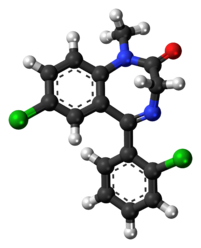
Back Diclazepam German دیکلازپام Persian Diclazépam French Diklazepam Croatian Diclazepam Italian Diclazepam Portuguese Diklazepam Serbo-Croatian Diklazepam Serbian
 | |
 | |
| Clinical data | |
|---|---|
| Routes of administration | Oral, sublingual |
| Legal status | |
| Legal status |
|
| Pharmacokinetic data | |
| Bioavailability | ? |
| Metabolism | Hepatic |
| Elimination half-life | ~42 hours[2] |
| Excretion | Renal |
| Identifiers | |
| |
| CAS Number | |
| PubChem CID | |
| ChemSpider | |
| UNII | |
| KEGG | |
| CompTox Dashboard (EPA) | |
| Chemical and physical data | |
| Formula | C16H12Cl2N2O |
| Molar mass | 319.19 g·mol−1 |
| 3D model (JSmol) | |
| |
| |
| | |
Diclazepam (Ro5-3448), also known as chlorodiazepam and 2'-chloro-diazepam, is a benzodiazepine and functional analog of diazepam. It was first synthesized by Leo Sternbach and his team at Hoffman-La Roche in 1960.[3] It is not currently approved for use as a medication, but rather sold as an unscheduled substance.[4][5][6][7] Efficacy and safety have not been tested in humans.
In animal models, its effects are similar to diazepam, possessing long-acting anxiolytic, anticonvulsant, hypnotic, sedative, skeletal muscle relaxant, and amnestic properties.[citation needed]
- ^ Anvisa (2023-03-31). "RDC Nº 784 - Listas de Substâncias Entorpecentes, Psicotrópicas, Precursoras e Outras sob Controle Especial" [Collegiate Board Resolution No. 784 - Lists of Narcotic, Psychotropic, Precursor, and Other Substances under Special Control] (in Brazilian Portuguese). Diário Oficial da União (published 2023-04-04). Archived from the original on 2023-08-03. Retrieved 2023-08-16.
- ^ Moosmann B, Bisel P, Auwärter V (July–August 2014). "Characterization of the designer benzodiazepine diclazepam and preliminary data on its metabolism and pharmacokinetics". Drug Testing and Analysis. 6 (7–8): 757–763. doi:10.1002/dta.1628. PMID 24604775.
- ^ US 3136815, "Amino substituted benzophenone oximes and derivatives thereof"
- ^ Pettersson Bergstrand M, Helander A, Hansson T, Beck O (April 2017). "Detectability of designer benzodiazepines in CEDIA, EMIT II Plus, HEIA, and KIMS II immunochemical screening assays". Drug Testing and Analysis. 9 (4): 640–645. doi:10.1002/dta.2003. PMID 27366870.
- ^ Høiseth G, Tuv SS, Karinen R (November 2016). "Blood concentrations of new designer benzodiazepines in forensic cases". Forensic Science International. 268: 35–38. doi:10.1016/j.forsciint.2016.09.006. PMID 27685473.
- ^ Manchester KR, Maskell PD, Waters L (March 2018). "Experimental versus theoretical log D7.4 , pKa and plasma protein binding values for benzodiazepines appearing as new psychoactive substances". Drug Testing and Analysis. 10 (8): 1258–1269. doi:10.1002/dta.2387. PMID 29582576.
- ^ Manchester KR, Waters L, Haider S, Maskell PD (July 2022). "The blood-to-plasma ratio and predicted GABAA-binding affinity of designer benzodiazepines". Forensic Toxicology. 40 (2): 349–356. doi:10.1007/s11419-022-00616-y. PMC 9715504. PMID 36454409. S2CID 247455284.
© MMXXIII Rich X Search. We shall prevail. All rights reserved. Rich X Search